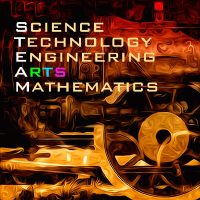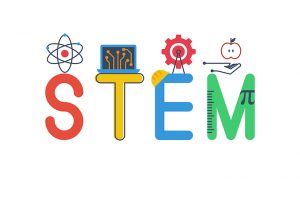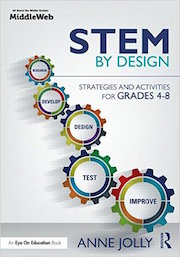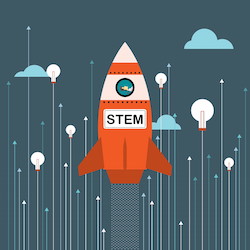Invest ESSA Funds in Real STEM Programs
A MiddleWeb Blog
 The new Elementary and Secondary Act, now called the Every Student Succeeds Act (ESSA), is a cause for some celebration, I think. Signed into law on December 10, 2015, ESSA places new emphasis on program flexibility and innovation.
The new Elementary and Secondary Act, now called the Every Student Succeeds Act (ESSA), is a cause for some celebration, I think. Signed into law on December 10, 2015, ESSA places new emphasis on program flexibility and innovation.
You might guess that I’ve saved my main cheerleading for the new funding and life ESSA pumps into K-12 STEM education.
For starters, these goals stand out to me:
(1) Prepare 100,000 excellent new K-12 STEM teachers by 2020. That means recruiting, preparing, and retaining new STEM teachers to fill the gaping void schools now face in successfully implementing this relatively new undertaking. And do it in four years’ time.
(2) Support existing STEM teachers. The bill calls for us to provide inventive and effective professional growth opportunities, and ongoing learning, for those who already pioneering this STEM journey. That’s really important because it takes years to bring highly effective new teachers on-line.
(3) Increase the number of students who have authentic STEM experiences by 50% each year. Among other things, this calls for a focus on how we teach STEM – what challenges kids will solve, what teaching method we will use, what types of lessons produce “authentic” experiences, and how we successfully integrate the STEM subjects so that kids grasp the engineering concepts that undergird STEM and apply them to solve problems.
(4) Better serve under-represented groups, including girls. All students must have equal access to opportunities and careers. STEM equity is essential.
The competition for STEM funds

It’s important to know that STEM is not the only academic area supported in the new law. ESSA increases federal funding set aside specifically for literacy and the arts and provides new funding for social studies, history, and civics (see also this site).
Federal funding is also available for health and physical education. A new reading/writing program (LEARN) is funded, and school libraries have gotten a revenue boost. ESSA also includes increased funding for ELL programs.
In high-needs schools, many academic programs are also specified as eligible uses of Title I funds – the long-standing and largest pool of federal resources dedicated to ensuring equitable access to a complete education for all students.
So why is everyone rushing to dip from the STEM funding stream?
One rationale goes like this: ESSA calls for all students to “have equitable access to high quality STEM and computer science education, which are part of a well-rounded education.” Since the term well-rounded is mentioned, all subjects must therefore qualify for STEM funds. But note that well-rounded, in this ESSA context, specifically applies a well-rounded STEM and computer science education. (In the bill itself, the only other area identified specifically as part of a well-rounded STEM program is the arts.)

Others argue for a broader definition based on a perceived lack of fairness. What’s so special about STEM that only science, technology, engineering, math, and art should be designated for STEM funding? They suggest that these five subjects constitute too narrow a focus.
Still others assert, there is no STEM crisis! It’s a manufactured conspiracy! Or, even more bizarrely, if we focus on STEM then liberal arts education will become irrelevant.
STEM vs. Humanities: It’s a phony fight
Certainly, other content areas have important connections to STEM. We shouldn’t ignore those relationships or minimize them. Our students do deserve a well-rounded education in all subjects. But giving them a solid STEM education doesn’t mean that we cannot offer a strong humanities education. The two are not mutually exclusive.
Likewise, educators in all subjects can collaborate to develop and use a common approach in helping students strengthen teamwork, communications, and other cross-curricular 21st century skills. Content from other subjects may be included to accomplish a specific engineering challenge. The Common Core State Standards make coordination particularly practical for language arts and math teachers. But in the STEM arena itself, the emphasis remains on deepening skills in math, science, and technology through engineering.
Designing a funding-worthy STEM program
I’d like to suggest that as you establish STEM programs and apply for STEM funding, you keep a couple of things in mind. When the National Science Foundation coined the acronym STEM in the 1990s, they did so to indicate that integrating these subjects (rather than teaching them in isolation) was necessary to maintain our technological edge and launch undreamed-of innovations in American society. Today, 21st century workers must use math and science together, along with current technology, in order to solve current and emerging problems in the real world.
Current K-12 education is not preparing enough future workers to do that. The programs we need to design and fund with STEM dollars should give students the kind of integrated math and science experiences they need in order to engineer inventive solutions for real problems.
I’m simply asking that you consider carefully the program you want to fund. Is it actually a STEM program, and does it makes sense to use monies intended for STEM initiatives to fund it?
Remember, K-12 STEM is an integrated approach intended to get students up to speed in applying important science and math concepts (using an engineering approach) to real-world problems. Doing this requires teamwork and a variety of creative thinking and entrepreneurial skills.
Will the program that you want to fund accomplish that? As I look around the nation, schools implementing STEM programs with that kind of fidelity seem few and far between, even though I believe that’s where the STEM funding should be going.
What STEM programs will ESSA monies fund?
This is a new and tough undertaking, and we need those STEM dollars to fund STEM initiatives.
Here’s a list of STEM funding priorities to guide your thinking about possible directions for STEM programs. Also note that the U.S. Department of Education sent this letter to states, districts and schools to encourage them to use federal dollars for developing, implementing, and expanding specific STEM classes for the 2016-2017 school year. You might also check out this article for additional ideas on leveraging federal funding to support your STEM education program.

These websites can help you locate additional STEM grants and funding:
► STEMfinity
► Edutopia grants and resources
► Grants for teachers
► Grants Resources in Science, Math and Integrated STEM
We owe it to our students to provide them an education that prepares them for a rapidly changing, always challenging world.

From the Amazon description: “This practical book…has all the answers and tools you need to get started or enhance your current program. Based on the author’s popular MiddleWeb blog of the same name, STEM by Design reveals the secrets to successful lessons in which students use science, math, and technology to solve real-world engineering design problems.”


































